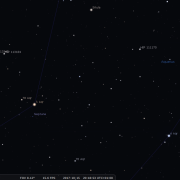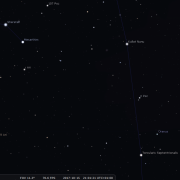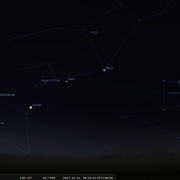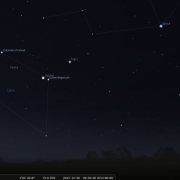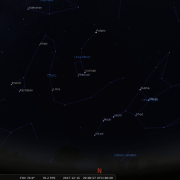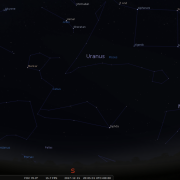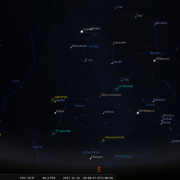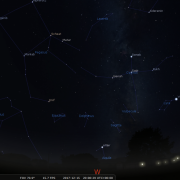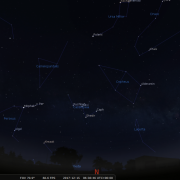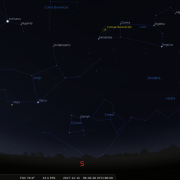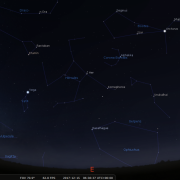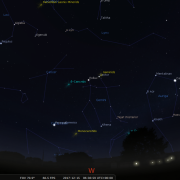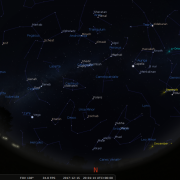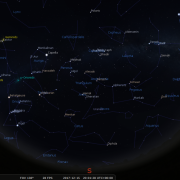In this month's Sky Notes:
Planetary Skylights
Evening
 Planetary wise it is an unusual ending to the year, with no bright planets visible in the evening sky. There are planets to be tracked down, but at magnitude +5.65 Uranus will require a pair of binoculars, and Neptune (mag +7.8) will in reality need a telescope to verify it.
Planetary wise it is an unusual ending to the year, with no bright planets visible in the evening sky. There are planets to be tracked down, but at magnitude +5.65 Uranus will require a pair of binoculars, and Neptune (mag +7.8) will in reality need a telescope to verify it.
Uranus resides in the ESE toward the bottom of the ‘V’ asterism in Pisces, not far above the star Torcularis Septentrionalis. Perhaps the easiest way to locate it is by using Sheratan and Mesarthim in Aries (the crooked leg of the ram) and sighting down five times the distance between them, and then up one. ‘Herschel’s planet’ will yield a very small grey/green disk in a telescope. The moon passes just below the bottom of the ‘V’ on the 27th.
 Neptune is located to the SSE in the constellation of Aquarius, and you will require a telescope to identify it. It resides below the asterism known as the ‘water jar’ not far beneath Lamda Aquarii. Through a telescope Neptune resembles a tiny blue/grey disk. The moon lies below/left on the 24th.
Neptune is located to the SSE in the constellation of Aquarius, and you will require a telescope to identify it. It resides below the asterism known as the ‘water jar’ not far beneath Lamda Aquarii. Through a telescope Neptune resembles a tiny blue/grey disk. The moon lies below/left on the 24th.
Morning

 Conspicuous planetary action is confined to the dawn sky, where Jupiter and Mars can be spotted. Mars lies upper right of brighter Jupiter as the month commences, but seemingly drops downwards and toward Jupiter as we head into the New Year, when a spectacular conjunction occurs on the 6th. The moon lies above and between on Dec 14th.
Conspicuous planetary action is confined to the dawn sky, where Jupiter and Mars can be spotted. Mars lies upper right of brighter Jupiter as the month commences, but seemingly drops downwards and toward Jupiter as we head into the New Year, when a spectacular conjunction occurs on the 6th. The moon lies above and between on Dec 14th.
 Finally, Mercury pops up smack above the SE horizon later in December. Look for the elusive planet from the 22nd onwards viewing around 07:15h. You will require a clear, unobstructed horizon and are looking for a reasonably bright ‘star’ approximately 4 degrees above it. Use binoculars if you cannot initially spot Mercury with just the naked eye.
Finally, Mercury pops up smack above the SE horizon later in December. Look for the elusive planet from the 22nd onwards viewing around 07:15h. You will require a clear, unobstructed horizon and are looking for a reasonably bright ‘star’ approximately 4 degrees above it. Use binoculars if you cannot initially spot Mercury with just the naked eye.
Meteors & Comets

Meteor activity reaches a peak at this time of year and given any clear skies the chance of spotting some shooting stars increases markedly. Considered to be the most prolific meteor shower of the year, the Geminids are active from December 7-16, reaching a peak on December 13/14th.
Geminids originate from debris shed by a small ‘object’ called Phaethon, an asteroid which may be the nucleus of a ‘dead’ comet. Phaethon passes within 10 million miles of the Sun causing the object to deposit material over great swathes of the inner solar system. It is the denser strands of this debris that Earth now encounters each year. In fact Geminids were not recorded before the 1860’s, and it is only during the latter part of the 20th century that Geminid activity has increased to the levels now witnessed, ie upwards of 120 per hour, although by the end of the 21st century rates will decrease again.
Typical Geminid’s are about the size of a large coffee granule and penetrate deep into Earth’s atmosphere at 22 miles per second, before ‘burning up’ - (two processes; known as ablation and ionisation) Generally Geminids produce fewer persistent trains than some showers, however bright examples (1st mag and below) quite often leave luminous trails, sometimes blue/ white, green, yellow or even orange in hue. These correspond to specific elements present in the meteoroid as well as the effect of interactions with air molecules due to velocity
The shower radiant lies close to Castor, visible in the east by 21:00h. Under ideal conditions the Zenith Hourly Rate (ZHR) can reach well over one hundred meteors, however actual observed rates by any one person are always substantially lower. If skies are clear, the late evening of the 13th will yield quite a few Geminids, but with the moon near new, the early morning hours of the 14th will afford the highest rates.
If clear, conditions should also be favourable for the much less prolific Ursid meteor shower. The shower is active from Dec 17-25th, peaking on Dec 22/23rd. Hourly rates of 8-12 are normal, however occasionally, and erratically, Ursids produce strong outbursts, so it is a case of watching the skies. The radiant lies close to the Great Bear- up in the NE.
November 2017 Sky Charts
|
Looking North
Mid-Decvember - 20:00h |
Looking South |
|
Looking East
Mid-December - 20:00h |
Looking West
Mid-December - 20:00h |
| Looking North (morning) Mid-December - 06:30h |
Looking South (morning) Mid-December - 06:30h |
| Looking East (morning) Mid-December - 06:30h |
Looking West (morning) Mid-December - 06:30h |
| Northern Aspect Mid-December - 20:00h |
Southern Aspect Mid-December - 20:00h |
Additional Image Credits:
- Planets and Comets where not otherwise mentioned: NASA
- Sky Charts: Stellarium Software
- Log in to post comments

